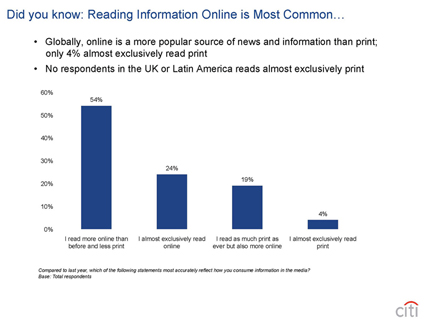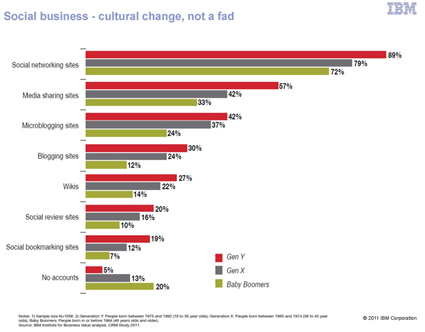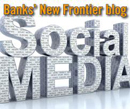New media isn't just for retail banking anymore
How Citigroup and others reach out to business customers
- |
- Written by Steve Cocheo

Earlier this year a banking conference speaker told his audience, "If you doubt the power of Twitter, ask Hosni Mubarak how he feels about it."
The power of social media to generate support for and supplement communications for a political revolution in Egypt received many headlines back then. Yet a quieter, commercial social media story was playing out in the same region at the same time-- among businesses that wondered if they could keep their financial operations going during the turmoil.
Managers of many Egyptian firms doing business with Citigroup’s Global Transactions Services division worried about operating while banks were closed, according to Leslie Klein, managing director and global head of GTS marketing. The country head for GTS recorded a video giving clients advice on business continuity, and within four hours the company had it posted on Market Guide, a channel that’s one of three private platforms it uses for communicating with customers.
Not every social media foray by Klein’s organization plays out on such a dramatic stage, but this illustrates the applicability of social media techniques to issues of more import than the latest sayings of Ashton Kutcher or the latest viral video.
(The other two Citi private channels are: CitiDirect BE Media Channel, which features thought-leadership articles and other types of content from Citi and external sources; and Reuters Insider media channel. Both are external, closed-loop platforms, versus open platforms like Youtube or Twitter, or internal platforms available only to Citi employees.)
The power of social media to generate support for and supplement communications for a political revolution in Egypt received many headlines back then. Yet a quieter, commercial social media story was playing out in the same region at the same time-- among businesses that wondered if they could keep their financial operations going during the turmoil.
Managers of many Egyptian firms doing business with Citigroup’s Global Transactions Services division worried about operating while banks were closed, according to Leslie Klein, managing director and global head of GTS marketing. The country head for GTS recorded a video giving clients advice on business continuity, and within four hours the company had it posted on Market Guide, a channel that’s one of three private platforms it uses for communicating with customers.
Not every social media foray by Klein’s organization plays out on such a dramatic stage, but this illustrates the applicability of social media techniques to issues of more import than the latest sayings of Ashton Kutcher or the latest viral video.
(The other two Citi private channels are: CitiDirect BE Media Channel, which features thought-leadership articles and other types of content from Citi and external sources; and Reuters Insider media channel. Both are external, closed-loop platforms, versus open platforms like Youtube or Twitter, or internal platforms available only to Citi employees.)
Social media for the serious set
"We’re coming a little bit late to the party," said Klein, but she allowed that alternative marketing and client communications have been moving more slowly on the B2B side. "It tends to move at a pace we can keep up with," said Klein, whose operation has been working with IBM on social media--IBM prefers the term "social business"—efforts both internally and externally.
Klein and other speakers quoted here made their remarks during a 90-minute seminar, "Social Business Is Driving the Bottom Line," sponsored by IBM. (See the end of this article for more details. See this article for specifics about CitiGTS’s Twitter efforts.)
"We’re coming a little bit late to the party," said Klein, but she allowed that alternative marketing and client communications have been moving more slowly on the B2B side. "It tends to move at a pace we can keep up with," said Klein, whose operation has been working with IBM on social media--IBM prefers the term "social business"—efforts both internally and externally.
Klein and other speakers quoted here made their remarks during a 90-minute seminar, "Social Business Is Driving the Bottom Line," sponsored by IBM. (See the end of this article for more details. See this article for specifics about CitiGTS’s Twitter efforts.)
GTS is a division of Citigroup’s Institutional Clients Group. It offers integrated cash management, trade, and securities and fund services to multinational corporations, financial institutions, and public sector organizations around the world. The division has over 65,000 clients worldwide.
Though the trend might be slower, this is not to say that the pace is glacial.
"Adoption and behavioral change are happening faster than at any time in the past," said Klein, so Citi has found social to be a moving target. She merely meant, to use her example, that business-side social media isn’t like trying to come up with what will appeal to 16-year-olds this week versus last week.
Klein cited proprietary research done for Citi by Harris among the bank’s clients that she found surprising.
Nearly 90% of the executives surveyed report using social media of some kind for business purposes, she stated. Among the international sample, Facebook led the usage volume, followed by Linkedin.
Additional research done for the company, again among a global sample, found that online has become a more popular source of news and information than print. More specifically, Klein said that:
• 54% of the sample stated that, compared to last year, they read more online than before and less print.
• 24% reported that they now read almost exclusively online.
• 19% read as much print as they ever did, but they also are reading more online.
• 4% almost exclusively read print.
"Where are their eyeballs? There is virtually nobody left who is in a print-only mode," said Klein. B2B businesses like GTS have to take this into account in determining how to reach their customers.
Business-to-business marketers relying on print for exposure are fighting a losing--nearly lost--battle, research done for Citicorp’s Global Transactions Services division indicates. Click here or on image for a larger version of the chart
Not your nephew’s social media anymore
B2B marketers must also understand that stereotyped generational preferences for social media are going by the boards, as well.
"Our surveys show that it’s no longer just Generation Y or Generation X," said IBM’s Boxley Llewellyn. "It’s the baby boomers too. It’s no longer the people without money who are doing it. It’s now everyone who is doing it." Llewellyn is director, growth initiatives, financial services sector, IBM.
CitiGTS maintains multiple external social media presences, including videos on its own site and on the Citi channel on Youtube; GTS blogs; Linkedin discussion groups; and Twitter posts. (See separate article concerning CitiGTS’ Twitter activities here.
B2B marketers must also understand that stereotyped generational preferences for social media are going by the boards, as well.
"Our surveys show that it’s no longer just Generation Y or Generation X," said IBM’s Boxley Llewellyn. "It’s the baby boomers too. It’s no longer the people without money who are doing it. It’s now everyone who is doing it." Llewellyn is director, growth initiatives, financial services sector, IBM.
CitiGTS maintains multiple external social media presences, including videos on its own site and on the Citi channel on Youtube; GTS blogs; Linkedin discussion groups; and Twitter posts. (See separate article concerning CitiGTS’ Twitter activities here.

Social media has long moved beyond the younger set, indicates research from IBM. Click here or on the image for a larger version of the chart.
Is B2B social working? Yes, but…
Klein gave listeners a definition of what CitiGTS considers to be social media’s role, at least for that organization: "A tool to reinforce the brand and enable messages to get out more quickly and frequently to target audiences."
On the CitiGTS-to-customers side, measuring the success of social media has been problematic. Klein indicated that for CitiGTS, the role of social media is still in flux. It serves as an additional means of reaching both internal and external audiences and complements the organization’s efforts in other channels.
Klein gave listeners a definition of what CitiGTS considers to be social media’s role, at least for that organization: "A tool to reinforce the brand and enable messages to get out more quickly and frequently to target audiences."
On the CitiGTS-to-customers side, measuring the success of social media has been problematic. Klein indicated that for CitiGTS, the role of social media is still in flux. It serves as an additional means of reaching both internal and external audiences and complements the organization’s efforts in other channels.
 |
Keep up with bank social media ideas, trends, and warnings Have you checked out our periodic blog, "Social Media: Banks’ New Frontier"? Both staff authors and outside experts cover case studies, key trends, best practices, and ways to protect your bank and keep it in compliance. The blog is an online companion to periodic articles in Banking Exchange magazine. |
"It’s a journey," said Klein. "There hasn’t been a big bang yet, a rollout that has changed things [dramatically]. But what has happened has happened very, very quickly."
"I can’t tell you that we can calculate an ROI for what we are doing," Klein continued. "But we have had measures of success in terms of audience and in terms of feedback when we ask for it." She noted that even social media practitioners still don’t agree on which metrics are most significant nor on what levels in those metrics indicate success.
Klein cited two examples of success, one internal to CitiGTS and one external.
Crowdsourced collaboration. The first was an online collaboration session that ran over three consecutive days. It was open to all GTS employees in an effort to "crowdsource" fresh ideas and concepts for the business. In part, the effort was designed to permit employees of all levels to engage directly with senior management and subject experts.
Klein said that more than 4,000 GTS employees from 88 countries, representing all levels and business areas, at least logged into the collaboration at some point during the three-day online event. The collaboration featured discussions in four subject areas, and participants made more than 6,800 postings. (The four discussion areas were "Unlocking Opportunities For Growth"; "Monetizing New Solutions"; "Working Smarter"; and "Ideas In Action.")
"We’re still mining all the ideas that we received," said Klein.
Citi videos. Externally, CitiGTS posts videos, as mentioned earlier, and those presented on its Youtube channel have been among the most popular content items the division has posted online. One example is video concerning innovation in the Arab sphere. This garnered more than 4,500 viewers.
Klein said this was much higher than she and fellow executives had expected, in a medium that is known more for content like old "Saturday Night Live" episodes as anything for business.
IBM’s Llewellyn said that video can be very supportive to an institution’s strategy.
"Video lets you reach out and put a face on a financial institution," he said.
"I can’t tell you that we can calculate an ROI for what we are doing," Klein continued. "But we have had measures of success in terms of audience and in terms of feedback when we ask for it." She noted that even social media practitioners still don’t agree on which metrics are most significant nor on what levels in those metrics indicate success.
Klein cited two examples of success, one internal to CitiGTS and one external.
Crowdsourced collaboration. The first was an online collaboration session that ran over three consecutive days. It was open to all GTS employees in an effort to "crowdsource" fresh ideas and concepts for the business. In part, the effort was designed to permit employees of all levels to engage directly with senior management and subject experts.
Klein said that more than 4,000 GTS employees from 88 countries, representing all levels and business areas, at least logged into the collaboration at some point during the three-day online event. The collaboration featured discussions in four subject areas, and participants made more than 6,800 postings. (The four discussion areas were "Unlocking Opportunities For Growth"; "Monetizing New Solutions"; "Working Smarter"; and "Ideas In Action.")
"We’re still mining all the ideas that we received," said Klein.
Citi videos. Externally, CitiGTS posts videos, as mentioned earlier, and those presented on its Youtube channel have been among the most popular content items the division has posted online. One example is video concerning innovation in the Arab sphere. This garnered more than 4,500 viewers.
Klein said this was much higher than she and fellow executives had expected, in a medium that is known more for content like old "Saturday Night Live" episodes as anything for business.
IBM’s Llewellyn said that video can be very supportive to an institution’s strategy.
"Video lets you reach out and put a face on a financial institution," he said.
"Feed the content beast"
The corollary when there is success in social media is that you have to continue feeding what Klein called "the content beast."
It’s insatiable--Klein warned that any organization getting into B2B social must make a commitment to content.
"You can’t have enough fresh content, and you have to plan for wind-down or for growth" once you begin, she said. "If your content isn’t fresh and it isn’t interesting, your customer is not going to be coming back. You can’t imagine how fast you need to produce new content."
Credibility is critical, too. IBM’s Llewellyn said that strong content puts the financial services provider into "trusted advisor" status.
"People don’t believe ads directly," said Llewellyn. "They want that trusted advisor."
Blogs run by Bank Leumi are one example, he said, where employee bloggers with various expertise have built followings among Israelis. Llewellyn also praised Australia’s Westpac for its "Ruby Connection," an online community that it maintains where women executives can advise each other on solutions to problems.
(The Leumi blog appears here; please be advised this is in Hebrew only. Read about the blog in English at this link. The WestPac blog can be found here.
The corollary when there is success in social media is that you have to continue feeding what Klein called "the content beast."
It’s insatiable--Klein warned that any organization getting into B2B social must make a commitment to content.
"You can’t have enough fresh content, and you have to plan for wind-down or for growth" once you begin, she said. "If your content isn’t fresh and it isn’t interesting, your customer is not going to be coming back. You can’t imagine how fast you need to produce new content."
Credibility is critical, too. IBM’s Llewellyn said that strong content puts the financial services provider into "trusted advisor" status.
"People don’t believe ads directly," said Llewellyn. "They want that trusted advisor."
Blogs run by Bank Leumi are one example, he said, where employee bloggers with various expertise have built followings among Israelis. Llewellyn also praised Australia’s Westpac for its "Ruby Connection," an online community that it maintains where women executives can advise each other on solutions to problems.
(The Leumi blog appears here; please be advised this is in Hebrew only. Read about the blog in English at this link. The WestPac blog can be found here.
Where are companies going for B2B social media?
"We believe that social media will do for the relationship of commerce what the Gutenberg printing press did for the spoken word," said B2B Magazine’s John DiStefano. "Social media is becoming the currency of relationship."
DiStefano said that 54% of the B2B market is engaged in some form of social media marketing. Quoting from a survey conducted by the magazine earlier in 2011 among 577 companies (B2B Social Communications: Insights From The Field), DiStefano gave these as the top five social media marketing uses:
* Branding--64%
* Website traffic building--55%
* Product/event promotion--54%
* Community building (social buzz)--52%
* Customer feedback--52%
DiStefano said the research went further and asked B2B marketers what their preferred usage was for each of the common platforms:
* Linkedin: Lead generation, cited by 57%
* Facebook: Branding, cited by 75%
* Twitter: Website traffic building, 69%
* Youtube: Branding, 64%
* Various blogging platforms: Branding, 72%
* Various customer feedback platforms: Customer feedback, 79%
The magazine’s research is available for sale on its own site at $149.
"We believe that social media will do for the relationship of commerce what the Gutenberg printing press did for the spoken word," said B2B Magazine’s John DiStefano. "Social media is becoming the currency of relationship."
DiStefano said that 54% of the B2B market is engaged in some form of social media marketing. Quoting from a survey conducted by the magazine earlier in 2011 among 577 companies (B2B Social Communications: Insights From The Field), DiStefano gave these as the top five social media marketing uses:
* Branding--64%
* Website traffic building--55%
* Product/event promotion--54%
* Community building (social buzz)--52%
* Customer feedback--52%
DiStefano said the research went further and asked B2B marketers what their preferred usage was for each of the common platforms:
* Linkedin: Lead generation, cited by 57%
* Facebook: Branding, cited by 75%
* Twitter: Website traffic building, 69%
* Youtube: Branding, 64%
* Various blogging platforms: Branding, 72%
* Various customer feedback platforms: Customer feedback, 79%
The magazine’s research is available for sale on its own site at $149.
Read more about Citi’s B2B social media efforts: This article is a companion to the Banking Exchange Social Media blog, "What Does A Mega Business Bank Tweet About?"
View offsite IBM video: This article is partially based on an Oct. 5 live presentation, "Social Business Is Driving the Bottom Line," made at IBM’s New York City Client Briefing Center. You can view the archived video of the presentation here.
Share your bank’s own B2B social media experiences in the comment section below.
Tagged under Management, Lines of Business, Compliance,













